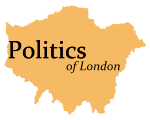
Back Transport for London Afrikaans هيئة النقل في لندن Arabic ট্রান্সপোর্ট ফর লন্ডন Bengali/Bangla Transport for London Catalan Transport for London Czech Transport for London Danish Transport for London German Transport for London Greek Transport for London Spanish Transport for London Basque
 | |
| Abbreviation | TfL |
|---|---|
| Formation | 3 July 2000 (Greater London Authority Act 1999) |
| Type | Statutory corporation |
| Legal status | Executive agency within GLA |
| Purpose | Transport authority |
| Headquarters | 5 Endeavour Square London E20 1JN |
Region served | London, England |
Chairman | Mayor of London (Sadiq Khan) |
| Andy Lord | |
Main organ | |
Parent organisation | Greater London Authority (GLA) |
Budget | 2019–20: £10.3 billion (47% of this from fares)[1] |
Staff | 28,000 |
| Website | tfl |

| This article is part of a series within the Politics of England on the |
| Politics of London |
|---|
 |
Transport for London (TfL) is a local government body responsible for most of the transport network in London, United Kingdom.[2]
TfL is the successor organization of the London Passenger Transport Board, which was established in 1933, and several other bodies in the intervening years. Since the current organization's creation in 2000 as part of the Greater London Authority (GLA), TfL has been responsible for operating multiple urban rail networks, including the London Underground and Docklands Light Railway, as well as London's buses, taxis, principal road routes, cycling provision, trams, and river services. It does not control all National Rail services in London, although it is responsible for London Overground and Elizabeth line services. The underlying services are provided by a mixture of wholly owned subsidiary companies (principally London Underground), by private sector franchisees (the remaining rail services, trams and most buses) and by licensees (some buses, taxis and river services). Fares are controlled by TfL, rail services fares calculated using eleven zones across the capital.
TfL has overseen various initiatives and infrastructure projects. Throughout the 2000s, a new radio communication system was implemented across its underground lines. Passenger convenience systems, such as the Oyster card and contactless payments, were also provisioned around this time. During 2008, the consumption of alcohol was banned on TfL services; this move has led to a decrease in anti-social behaviour. On 16 August 2016, TfL oversaw the launch of the Night Tube scheme, which introduced through-the-night services on both the London Underground and London Overground. Perhaps the biggest undertaking it has been responsible for, in this case shared jointly with the national Department for Transport (DfT), was the commissioning of the Crossrail Project; since its completion in 2022, TfL has been responsible for franchising its operation as the Elizabeth line.[3]
In addition to the GLA, the central British government used to provide regular funding for TfL, however this was tapered off during the 2010s with the aim of the organisation becoming self-sufficient. Direct central government funding for operations ceased during 2018.[1] During 2019–2020, TfL had a budget of £10.3 billion, 47% of which came from fares; the remainder came from grants, mainly from the GLA (33%), borrowing (8%), congestion charging and other income (12%). In 2020, during the height of the COVID-19 pandemic, fare revenues dropped by 90% and TfL obtained multiple rounds of support from the British government. It also responded with various cutbacks, including a proposal for a 40% reduction in capital expenditure.
- ^ a b "TfL funding". Archived from the original on 30 September 2015. Retrieved 21 January 2016.
- ^ "Company information". Transport for London. 2019. Archived from the original on 28 January 2019. Retrieved 16 March 2019.
- ^ "Our role". Transport for London. Archived from the original on 3 February 2016. Retrieved 29 January 2016.
© MMXXIII Rich X Search. We shall prevail. All rights reserved. Rich X Search